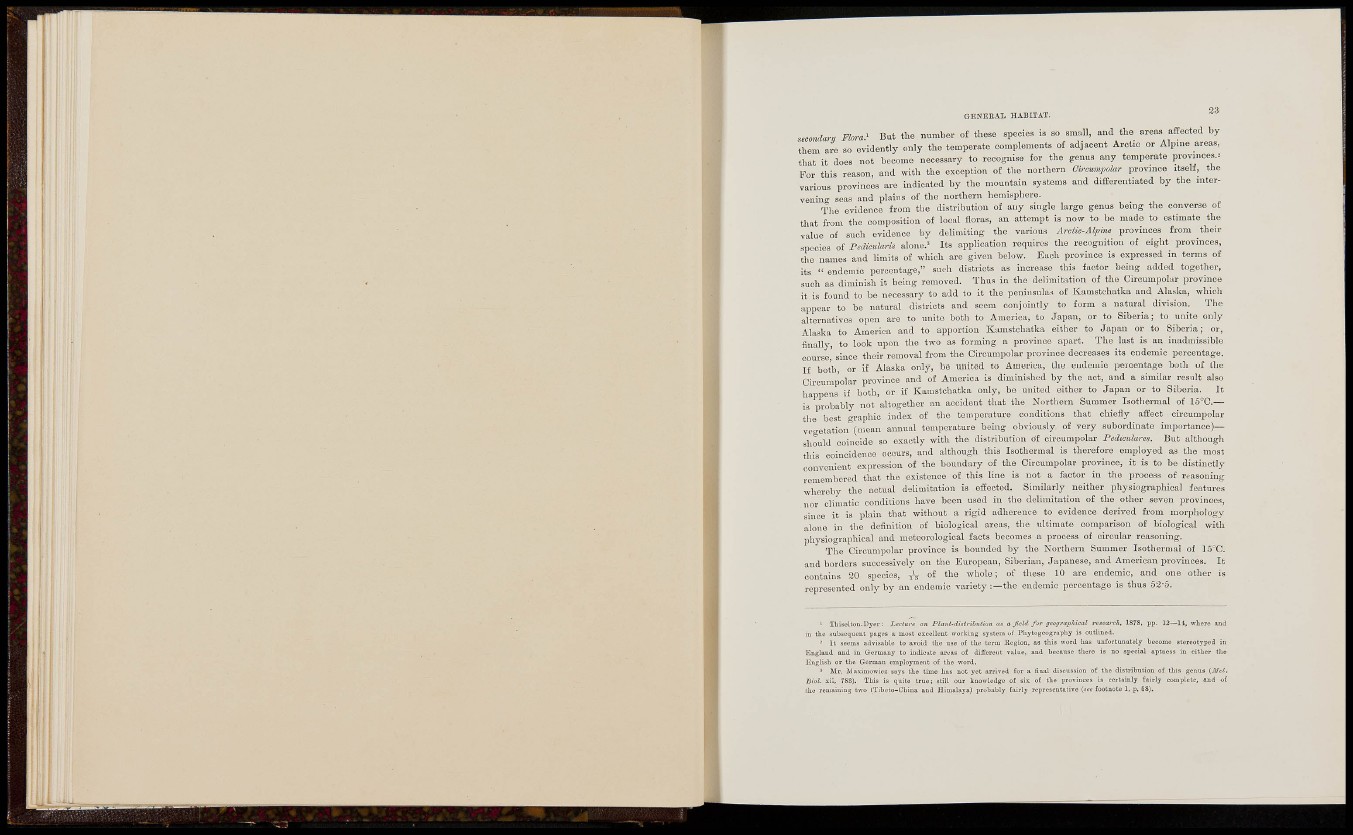
GENERAL HABITAT.
ucoudan m- a ^ Bat the number of these species is so small, and the areas aBected by
them are so evidently only the temperate eomplements of adjacent Arctic or Alpine areas,
that it does not become necessary to recognise for the geaus any temperate proTmces..
For this reason, and with the exception of the northern Circumpolar proTinoe itself, the
varions provinces are indicated by the mountain systems and differentiated by the intervenin
» seas and plains of the northern hemisphere.
Tlie evidence from the distribution of any single large genus being the converse of
that from the composition of local floras, an attempt is now to ha made to estimate the
value of such evidence by delimiting the Tariou.3 Arctie-Alfine provinces from their
species of Peiieulmril alone.' Its application requires the recognition of eight provinces,
die names and limits of which are given below. Each province is expressed in terms of
its " endemic percentage," such districts as increase this factor being added together,
such as diminish it being removed. Thus in the delimitation of the Circumpolor province
it is found to be necessary to add to it the peninsulas of Kamstcliatka and Alaska, which
appear to be natural districts and seem conjointly to form a natural division. The
alternatives open are to unite both to America, to Japan, or to Siberia; to unite only
Alaska to America and to apportion Kamstchatka either to Japan or to Siberia; or,
finally, to look upon the two as forming a province apart. The last is an inadmissible
course' since their removal from the Circumpolar province decreases its endemic percentage.
If both or if Alaska only, be united to America, the endemic percentage both of the
Circumpolar province and of America is diminished by the act, and a similar result also
happens if both, or if Kamstchatka only, be united either to Japan or to Siberia, It
is probably not altogether an accident that the Northern Summer Isothermal of lo'C.—
the best graphic index of the temperature conditions that chiefly affect circumpolar
vegetation (mean annual temperature being obviously of very subordinate importance)—
should coincide so exactly with the distribution of circumpolar Feiiaiares. But although
this coincidence occurs, and although this Isothermal is therefore employed as the most
convenient expression of the boundary of the Circumpolar province, it is to he distinctly
remembered that the existence of this line is not a factor in the process of reasoning
whereby the actual delimitation is effected. Similarly neither physiographical features
nor chinatic conditions have been used in the delimitation of the other seven ¡irovinces,
since it is plain that without a rigid adherence to evidence derived from morphology
alone in the definition of biological areas, the ultimate comparison of biological with
physiographical and meteorological facts becomes a process of circular reasoning.
The Circumpolar province is bounded by the Northern Summer Isothermal of 15°C.
and borders successively on the European, Siberian, Japanese, and American provinces. It
contains 20 species, of the ivhole; of these 10 are endemic, and one other is
L only by an endemic variety the endemic percentage is thus 53'5.
' Tbiseltoo-Dyer: Zeiiaw on Plant-distrihUion as a fieU for geograpJikal reseny^k. 1878, pp. 12—11. wiiere and
ill the subsequeul pages a must eseellent workiug system of Plijtogeograplij is outlined.
• It seems advisable to avoid tlie use of tke türm Kogioo. as tkis ivord lias uufortunately beeome stereotyped in
England and in Germany to indicate areas of diHereet value, and because there is no special aptness in either the
English or the German employment of the word.
= Mr. Madmowiez says tlio time has not yet arrived for a final discussion of the distribution of this genus {Mil.
Sioi. xii, 7SS). This is quite true; still our knowledge of siv of the provinces is certainly fairly complete, and of
the remaining two (Tiboto-Chiua and Himalaya! probably fairly representalive (see footnote 1, p. 68).